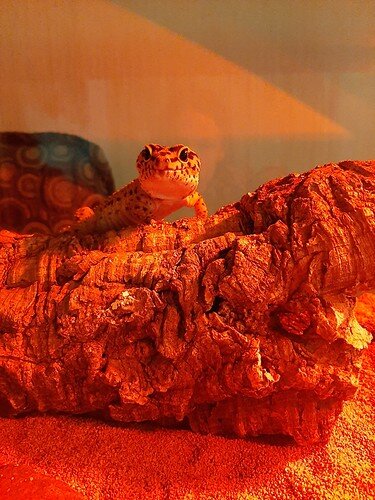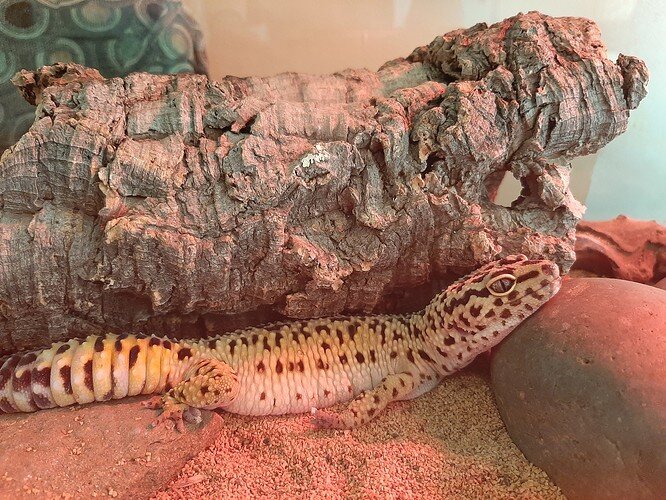I’m guessing that, if he has vision issues that are only developing now, it’s probably either from malnutrition (since he hasn’t been getting supplemented food) or xanthomatosis affecting the eye from having a high-fat diet for so long, with possible trauma to both eyes as a much less likely scenario.
You could take him to a reptile vet or veterinary ophthalmologist. They would be able to take a very good look at his eye (cornea, lens, retina, etc.) and check for cataracts/lenticular sclerosis, corneal xanthomatosis, and abrasions or corneal scarring. If they find something, that would be the best way to start trying to figure out what’s going on.
However, most are not willing to spend the money needed for exam/diagnostics for loss of eyesight in leopard geckos. The good news is, so long as the eye issues aren’t a sign of something more serious, a gecko can live a very good life while blind. If the blindness is a result of lack of supplementation or a diet too high in fat, then the condition will often stabilize once the errors in husbandry have been corrected. I have had geckos that have gone blind, and right now I have a gecko that has had an enucleation (eye removal) on one side, and she’s doing fantastic!
Just do what you can to keep his environment free of any pointy/sharp edges. Keep his hides in the same place, so that he can learn by feel where to go. If he is blind I also suggest tong-feeding, to avoid him trying repeatedly to strike prey, then getting mouthfuls of walnut when he misses, which could cause a lethal blockage. With my geckos with sight issues, I started always tapping the edge of the tongs in the same spot before feeding, so they learned that tapping means it’s time to go into ‘food’ mode.
Since he has not been regularly supplemented, I would start off dusting all of his food, at every feeding, with Calcium Plus, for a week or two. Then, for the next 2 weeks after that, I’d alternate: 1 feeding with Reptivite or Calcium Plus, 1 feeding Calcium with D3, 2 feedings Calcium without D3, then repeat. Make sure the superworms, crickets, and dubia are gutloaded for every feeding too. After that, you can switch to a more normal supplementation schedule.
The other thing to do is to make most of his food healthier. A diet high in fat over many years can have negative health consequences for a lot of geckos. It’s possible that a diet too high in fat could be causing corneal opacities in Gak’s eyes, or even tumors inside the globe of the eye itself.
The best food for leos is the black soldier fly larva (BSFL), they require less supplementing than most other feeders. However, they are often considered less palatable by picky eaters, so I’d work on getting Gak to accept dusted ‘tasty’ food before trying to switch to something healthier. Hornworms and silkworms are great for increasing water consumption (important for blind animals that may not be able to drink on their own), and have much less fat than mealworms/supers. Right now, it’s so cold where I’m living, I’m actually feeding almost entirely ‘Grub Pie’ (by Repashy). It’s a powder you mix like you would jello, to make a semi-solid that you can cut little bug-sized strips off and feed via tongs. You can also put powder on it to supplement, like you would a feeder insect. For a few of my guys, it was very difficult to switch them over, but now it’s super awesome not to have to tend to so many feeders.
Related husbandry stuff:
-
Crickets, if gutloaded, can be healthy, but uneaten crickets should never be left in the terrarium with Gak after feeding. Crickets can literally eat through the body wall of a gecko while it’s sleeping, though usually the problems aren’t that severe, I’ve seen it happen with a rescue I tried to save afterwards. Crickets that have not been gutloaded contain very little nutrients and have a very improper Ca:P ratio naturally.
-
Dubia should mostly be fed a low-protein diet, so that they don’t develop crystals of uric acid that the gecko would then ingest. If your gutloading food is high in protein, make sure you only offer it right before feeding.
-
With regards to substrate, I’m a big believer in paper towel. If you are going to naturalistic, I have heard good things about Excavator, but I’ve not used it myself. I’m pretty sure I remember walnut shell bedding being linked to respiratory issues, but to be honest I’m having a bit of a brain fart about specifics at the moment. Since Gak has eyesight issues, I’d say a switch to paper towel is definitely warranted, so that his environment stays consistent and he can find his way around more easily. Also, with paper towel, under tank heating becomes an option, whereas very thick layers of another substrate would necessitate the use of overhead heating methods. (Never use heat rocks.) If you are super attached to using loose substrate, see if you can teach him to eat from a dish.
-
It’s more complicated than it sounds to come up with the ideal supplementation schedule, because there are so many different types of feeders with variable Ca:P ratios. I’ve also gotten a lot of different opinions from different reptile vets. I’m still working out what is the best for my own collection. Because I’m feeding the Grub Pie right now, and it’s nutritionally so different from a lot of feeders (it’s mostly made of BSFL), I’m not supplementing as much as I do when I’m feeding hornworms. The trick I’ve learned is that geckos will often get ‘fat armpits,’ little bubbles that form in their axillary region, when they are being over-supplemented. I have quite a few geckos, so if I notice that their armpits are forming bubbles, I know I’m overdoing it.
-
I’d try to raise his hotspot to 85-90*F, 80 is too low.


 )! So her enclosure gets cleaned way more often than almost all of my other geckos, hehe.
)! So her enclosure gets cleaned way more often than almost all of my other geckos, hehe.